
What happens when you are called upon to illustrate a book requiring extensive research because it is both fiction and historical at the same time? A rush of excitement.
It means research and time travel. It also justifies my overflowing library of costume reference books.
It's a challenge to uncover the mystery of period costume and all it entails. What can I get away with, and what will be noticed by other perfectionists like me? At times like this, I'd give anything to be a textile conservator at the Victoria and Albert Museum, or even the Smithsonian.
This project involved the Revolutionary War. It was a fictional story mixed in with real events including George Washington himself. Having been married to the head archivist at Mount Vernon proved to be a big advantage. I already had a built-in knowledge of the time period, as well as an established familiarity with our first president.

I began a flurry of sketches.
How do I make the costumes believable? By stripping back the layers to really understand the structure of clothing, naturally. What was decoration, and what was functional? It was important for me to understand how garments were sewn. How did they fasten? What were undergarments composed of?
I found some of my reference materials in unlikely places. The movie Last of the Mohicans was an invaluable resource.
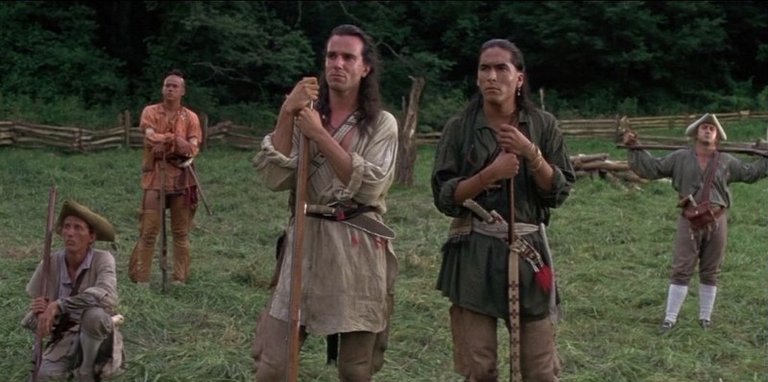
Not that it was too difficult to watch the movie, pausing it as needed to sketch Nathaniel and Uncas in their frontier garb. By watching movies, I understand better the overall functionality of clothing and how it can help or hinder movement. The French and Indian War may have taken place 20 years earlier, but it was close enough that clothing had not changed much.

This rough page of sketches helps me make the mental connection of how figures move in the clothes they wear. This was not an era of Gore-Tex and other high tech waterproof materials. Things must have been pretty uncomfortable all around. I imagined the blisters inflicted by the friction of wet leather. Maybe that would be the least of your troubles. How about being barefoot in the snow?
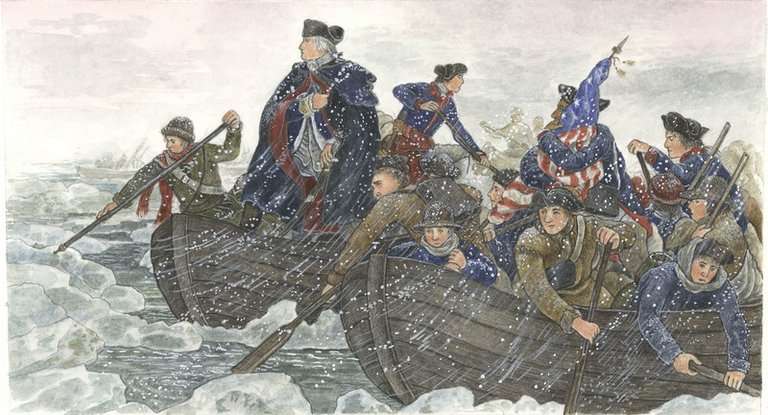
I wanted to highlight the effect the freezing temperatures had on the soldiers more than the bravery of the Delaware crossing.
I had to get into the time period of my characters and ask questions. "Why?" and "How?" were the two biggest ones. For example, if you were an American soldier, what would be the most efficient way to lug all your gear around? What made sense and why? Everything would have to be easily accessible. There was also the question of placement. Where were weapons carried, and how about gunpowder? As a soldier, you were probably a farmer or working class citizen arriving to fight ill-prepared and ill-equipped to withstand the elements.
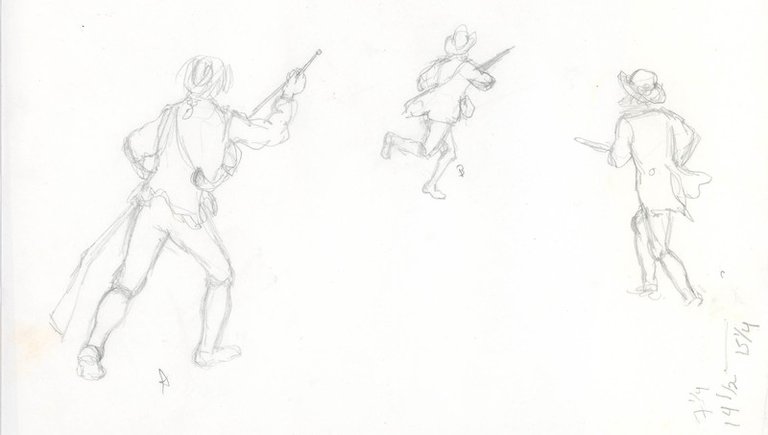
initial rough layout sketches become
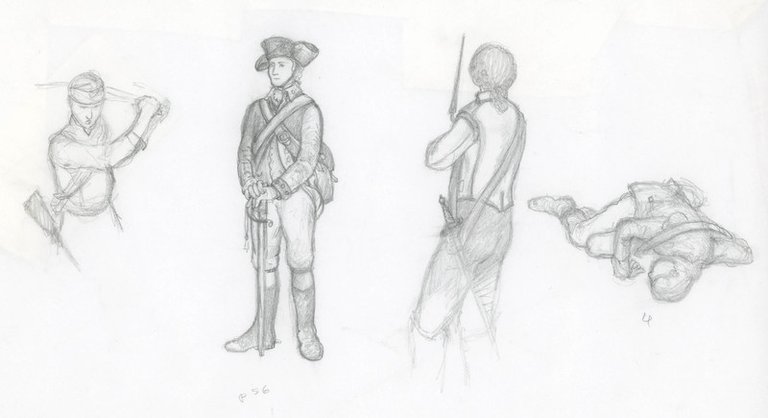
this more finished state

The reason these look like clippings is because they were. When I compose my illustrations, sometimes it's easier to pick them up like puzzle pieces and arrange them into a scene.

You can see how I inserted the figure studies into the finished painting.
When illustrating an educational book, I thought accuracy and attention to this kind of detail would be high on the list of priorities for schools as well.
I was wrong.
I learned something new. When depicting a grisly battle scene, one may portray muskets....minus the bayonets. I was told to eliminate them from my illustrations, because bayonets are too violent. I am not one to exaggerate violence in my work. But I do not believe we do anyone, children in particular, a service by sanitizing the horrors of war. Bayonets were used. War is horrible. Muskets were used to kill people, and bayonets were as well. You can bet the resulting battles were nothing less than indescribable bloodbaths from all the stabbing.
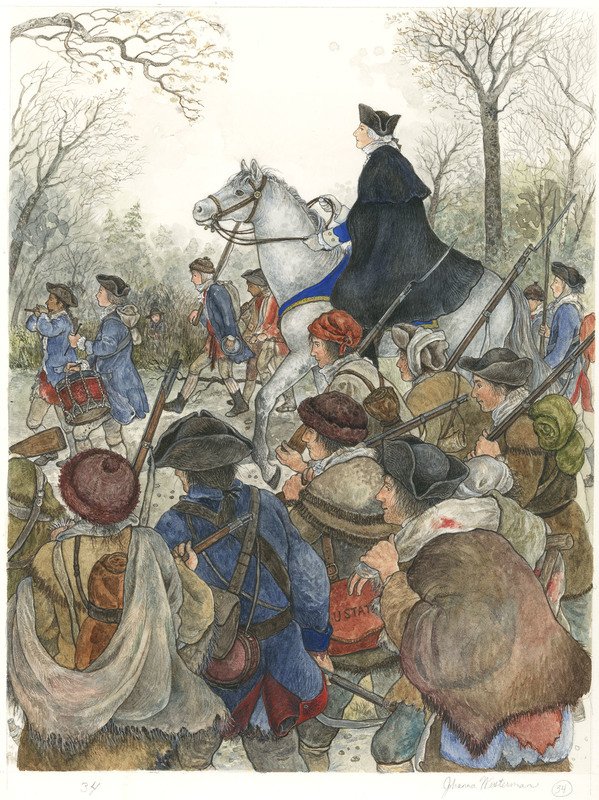
They were fine with bloodstained clothing and injured soldiers. (And an edit - bayonets were fine to show if they weren't being used in a battle scene.)
Now for an interesting side note. Originally, I intended to share my sketches and how they developed into a finished book. I didn't set out to take a political direction with my illustration post, but found it somehow evolved into a bit of a rant. I am angry, and here is one of the many reasons why.
During our recent trip to England, our friends introduced us to an interesting chap who happened to have been a writer for history text books. And the quest for authenticity has been censored more than you can imagine. For the American market, not only was he told to omit many truths of this country and its founding, he was actively "encouraged" to change the outcomes of many events to put the USA in a more favorable light. Was I surprised? Sadly, no. This sinister undertone is to keep us unaware of real historical events with the premise of teaching our kids only what they want us to know. Our high school kids are reading fiction, not historically accurate facts.
As much as I enjoyed working on this book, it was a sobering realization that we are not teaching history the way it really happened. I could be as accurate as possible with the way people dressed. But when it comes to the real horrors of war, it's best to play it down.
If you think about it, isn't that what our country is great at doing these days? Creating distractions while government-created atrocities wipe out thousands of innocent women and children every day?
Whatever you do, don't show bayonets to children.
How ironic that illustrating an educational picture book portraying the victories of our first president had to be censored for violence.
That is something to think about.
Illustrations ©Johanna Westerman 2016
Movie still, Last of the Mohicans, 20th Century Fox, 1992
Indeed we try to sanitize existence for children in the hopes of retaining their innocence. All it does, meanwhile, is create resentment as we learn we've been lied to.
People think I am strange for not believing in history per my indoctrination, but the way I saw it was that they lied. Thanksgiving, xmas, tooth fairies and other stories fabricated to gain my cooperation. I was super resentful as a teenager as a result.
The problem is the denial. Most people accept what is told to them as fact. The question to ask is cui bono, or who benefits? Where's the money?
Well said, @prufarchy. "Fabricated to gain cooperation." Same old theme, isn't it?
If the method isn't broke why fix it, I guess they believe. Meanwhile, maybe if children saw bayoneted victims of war they'd be less inclined to glorify it later in life, when it's gussied up in patriotic clothing.
I agree completely.
Indeed, it is because children are more innocent, that we have an obligation to tell them the truth. It is more deceitful to lie to a gullible child than to lie to a jaded adult because the child will be more deceived. If you think about it, the only real way to preserve someone's childlike trust is to tell them the truth. Lying to preserve someone's innocence is a contradiction in terms.
Yes indeed. We have no option but to explain to them the truth in its entirety and hope they have the childlike innocence to see a solution where we only see obstacle
It's a shame that we convert our only hope into our mirror image
Your posts always give me a great deal to think about.
Thank you, Miss @opheliafu. Miss you!
Miss you too! 😊
Always interesting and thought provoking.
Thanks, @team101.
Great pictures. I love the history, which so often turns out to be a little different than we learned in school.
Yes, and now that we have our own children, it's more apparent than ever. Thank you, @donkeypong.
Stunning. And so incredible to see the working/researching prep process. I really enjoyed the explanations!
Thank you, @hansikhouse. Research is always the best part.
Always enjoyable to read your posts @fairytalelife. It is a sad fact that history is written by the winners and rarely do the winners want their despicable acts to be remembered. Thank you for sharing, both your words and your artistic talent.
Thank you, @handsolo. Yes, reminds me of the line in Braveheart - "History is written by those who hang its heroes" - something to that effect. Did I actually just quote a Mel Gibson film? It's always a pleasure to read your comments, @handsolo. Cheers to you.
this is infuriating and ridiculous. AND your illustrations prior to censorship are absolutely fantastic! They are alive and active and I can feel and see so many levels of the scene, the experiences. What a shame that US chidren are deprived of the real story and then we grow up as cynical adults who don't trust what's told to them because so much of it was lies. A sad vicious circle.
All too true, @natureofbeing. Thank you for your comment. I am angry I believed them all.
This is such a good post. It ended up being so different from what I expected. You're so right. They work so hard to keep the general public ignorant and patriotic.
Thanks, Eric. Yes, it evolved into this. Funny. Sometimes we have to go where our writing takes us. I was surprised too. But why not? The bayonet bit came flooding back. At the time I was stunned it could be an issue.
Resteemed.
We try to teach our children not to lie.., to be truthful -- as we lie, right to their face. In words. In writing. And images, too. At the "state level" governments are out of control, rewriting (trying to) history, on a daily basis. All to make it fit into their image and definition of "American Exceptionalism" -- whatever the the fuck that is…
Isn't it common sense.., to know, in order to evolve, grow as a people -- a whole.., we must recognize the "sins of the past." And face them with a steely grit.., honestly… Not stare at them through rose colored glasses, waving a flag.
As always @fairytalelife, your post sparks a flame of truth, on things that can only survive in the dark.
Great post! I loved the artwork!
This is fascinating. Not only absolutely beautiful sketches and characters in progress... but very interesting to hear your first-hand account of censorship. Our culture has a dangerous habit of beautifying battle scenes and embellishing gun-wielding heros. (Education, news, film...) The reality is, when we see bloodless depictions of war and the proud-chested victors smiling - we think, hey, that's not half bad... in fact, that looks exciting! Over-sanitizing can be such a damaging thing to a young person as they develop a perspective of the world.... Anyway, great post. And on a lighter note - I love the movie Last of the Mohicans!
Thanks, @voronoi. It is alarming, isn't it? How else do they get 18 year olds sucked in to war?
Last of the Mohicans - one of my favorite films. We lived in Asheville NC briefly, and hiked up to the spot where poor Alice and Uncas met their untimely ends. It's beautiful up there in the Blue Ridge mountains.
Hi @fairytalelife
Very interesting and thank you for sharing.
I love it! Especially the guy carrying his friend in the last picture, the way his eyes are, not destroyed by the darkness of the war.
P.S: I didn't know you have to do so much research for historical illustration, it's only logical, just from the outside we tend to think that everything is easier.
Oh, the alien says YO! :)
YO!! Thank you. I'm so glad you enjoyed this post. You are so observant, Adil. :)
These are really lovely illustrations, congrats on some great work.